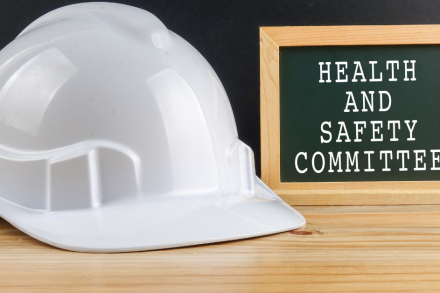
Employee-based workplace safety committees may not be perceived as the “coolest” employee groups in a workplace, but their duties are worth respecting. With a workplace safety committee that includes employees, you as a manager can encourage your staff to be active participants in their personal safety and health at work.
They can also become a valuable asset in the development and implementation of an effective health and safety program.
In other words, workplace safety committees can be made to work well, so long as they’re taken seriously and organized properly. Here are answers to several key questions you might have about organizing your own employees into a functioning safety committee.
What is an Employee-Based Safety Committee?
Just as its name suggests, an employee-based workplace safety committee is a group of employees either selected by management, their peers, or volunteers that participate in a committee or team to help implement and monitor the health and safety of the employees that work at that location.
The committee must be properly structured and managed to be effective. The employee and management members of a safety committee must be carefully chosen and should at least have an interest in health and safety issues.
Committee members will have to be willing to take on the responsibility for communicating any safety policies and procedures to the employees they work with. They also need to understand that most accidents and injuries are usually caused by unsafe acts and unsafe work practices and NOT unsafe conditions, which is, unfortunately, the premise upon which most safety committees are founded.
How do Employee-Based Safety Committees Impact Worker Health & Safety?
Fundamentally, having your company form an employee-based workplace safety committee should help reduce the number and severity of workplace accidents, injuries, or safety hazards in general. While this might work well in larger companies and corporations that have in-house staff with health and safety expertise, these committees do not always work in practice in smaller to medium-sized companies.
The problem is, that without the knowledge and expertise of what the committee should do, most of these companies’ committees languish for a short period and become largely ineffective and even the members of the committee lose interest in participating.
Unfortunately, most of these companies without expertise tend to focus on the wrong things. In actuality, the majority of workplace injuries we’ve seen are the result of those unsafe acts or work practices. This includes people using the wrong tools for the job, trying to do jobs they are not trained to do, taking unnecessary risks to get a job done, and, frankly, just making very poor decisions about how to do something safely.
These accidents are driven by workers’ behaviors and NOT necessarily by unsafe working conditions, such as a missing guard on a machine or a slippery floor. Since it is very difficult for someone not trained in recognizing unsafe behaviors to see them as such, a large number of these smaller company safety committees tend to make the mistake of focusing on OSHA compliance issues or unsafe conditions. They do this by conducting inspections or walkarounds to find and document these unsafe conditions like the absent guard and the wet floor. From there, they’ll write up a work order to have it fixed and then hand it over to the maintenance department to fix it.
We call this kind of safety committee a Find and Fix Safety Committee, which will inspect, find something wrong, write it up so it gets fixed, and then get caught in a cycle because the cause of the problem wasn’t addressed. Nobody called out the employee’s behavior, which lead to the issue arising in the first place.
In What Industries do Employee-Based Safety Committees Play the Biggest Role?
Employee-based workplace safety committees can be formed in pretty much any industry or type of workplace. Even completely white-collar office settings can be places where accidents or injuries happen because of unsafe behaviors. Filing cabinets with all the “heavy” files in the top draws can fall over and slippery floors can be just as slippery as those in manufacturing plants. And, there are maintenance workers in office buildings that use power tools, ladders and work on electrical equipment where they are very capable of exhibiting unsafe behaviors that result in injuries.
Obviously, though, worker safety committees are especially useful in companies that involve physically demanding or naturally dangerous work. Production plants with heavy machinery, jobs where employees have many materials handling duties and not many ergonomically designed work areas, laboratory settings that work with biohazards and chemicals, and companies in which lots of driving is required are all great candidates for forming an employee-based workplace safety organization.
In New Hampshire, the Department of Labor does not mention Safety Committees but rather refers to them as Joint Loss Management Committees that are required for companies with greater than 15 employees. Among other things, the statute requires a Written Safety Program and, more importantly, the involvement of employees on that committee, among a host of other stipulations.

Whose Responsibility is it to Put Together and Lead an Employee-Based Safety Committee?
Outside of New Hampshire, fourteen states have rules that make employee safety committees obligatory for most companies. Other states require them only for high-hazard job sites based on criteria such as the level of worker’s compensation rate or DART rating. Essentially, the laws around these organizations vary from state to state.
Fundamentally, employers are responsible for helping, equipping, and training their employees on how to form an employee-based safety committee. Employees can however push for their creation and thus push for management staff to help them organize the committee and provide it with resources for doing its job. In some states, such as Alabama, any company that has an employee request the formation of a committee must do so. This is not a condition of the New Hampshire statute.
What does OSHA Say About Employee-Based Safety Committees?
OSHA provides free workplace safety training and consultation sessions for companies in all 50 states. The kinds of companies that get priority attention with these training programs from OSHA Area offices throughout the country are those with fewer than 250 employees per location or 500 across the entire country and companies that work in industries or settings known for being particularly hazardous.
Oddly enough, despite having been around since 1970, OSHA rules don’t specifically mandate employee-based workplace safety committees or even written safety programs. If safety committees are required, individual states are generally the ones that mandate them.
How Often Should Employee-Based Safety Committees Convene?
Your New Hampshire company’s employee-based workplace safety committee must meet at least quarterly by statute. Based on the state of your safety committee and its degree of success, you could choose to meet more often but it is average for them to meet quarterly. You should also convene the committee more often if your workplace is unusually hazardous, or if new federal and NH state worker safety laws have gone into effect that employees need to know about.
 What Factors Can Negatively Impact an Employee-Based Safety Committee?
What Factors Can Negatively Impact an Employee-Based Safety Committee?
Regardless of whether workplace safety committees are legally required or not, employers can do a lot to either cultivate or neglect them. We find that the Find and Fix Committees are generally short-lived and do not provide much value as the employees that are on them generally become disenchanted by a lack of success. Generally, that lack of success comes from a lack of leadership on management’s part and NOT the employees’.
Management not addressing the committee’s concerns can also be a problem. With a lack of safety and health understanding or expertise, employees sometimes don’t really understand the difference between an employee issue versus it being a safety-related issue.
If management chooses not to address that issue, the employees may become disenchanted and it could lead to dissension in the committee. Sometimes it is best to address the employee concern as a safety-related issue to get the buy-in of the group so they will address much more serious safety issues when they arise.
Finding Professional Guidance
An effective safety committee might be able to help a company reduce its worker’s compensation premiums and its accident, injury, and disability rates.
If you as an employer want to make sure that your employees are kept as safe at work as possible, for the sake of basic workplace etiquette and employee engagement, possible workers’ comp premium reductions, and OSHA compliance liabilities, workplace safety should be a priority.
Consult with the professionally trained workplace safety consulting experts at Lawson Group to decide what your best options for organizing programs in your company are.







 What Factors Can Negatively Impact an Employee-Based Safety Committee?
What Factors Can Negatively Impact an Employee-Based Safety Committee?